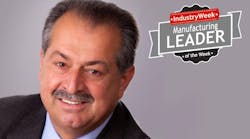Dow's Andrew Liveris and the Challenge of 'Dual Horizons'
How do you manage constant disruption while making sure your company is addressing its long-term goals? It’s a challenge Dow Chemical CEO Andrew Liveris spoke to at the recent IHS CERAWeek conference in Houston. His answer: focus on what he calls “dual horizons.”
Liveris, 61, said company leaders need to address the short term with a “maniacal focus on productivity” and constant attention to metrics that drive behavior. He said digitization and the Internet of Things is allowing companies to make “smarter decisions about resource allocation,” but it is also creating “massive distortions in the global economy because of the volatility it induces.” This volatility forces even huge companies to “have to pivot like startups and small companies,” said Liveris, and that is no easy task.
In fact, at the World Economic Forum in January, Liveris postulated, “Large, diversified industrial companies, conglomerate structures of the publicly owned variety, are doomed.”
The irony in that observation, of course, is that Liveris is a principal architect of one of the largest industrial mergers in history, the marriage of Dow Chemical (IW 500/20) and DuPont (IW 500/38). That “merger of equals,” announced last December, will result in a $130 billion colossus focused primarily on agriculture and materials. Liveris will serve as executive chairman of the new DowDuPont and DuPont’s Ed Breen will become CEO of the combined enterprise.
Asked about the logic of the deal, Liveris told an IHS CERAWeek audience that industrial companies face an “arms race” to scale up CAPEX and R&D spending in order to take on large societal challenges such as providing adequate energy, food and water to a growing global population. Diversified firms need to both scale up and achieve greater focus, and that puts a huge strain on resources in companies trying to invest in many different businesses. Liveris said the merger of Dow Chemical and DuPont is designed to meet that challenge.
See IndustryWeek's Previous Manufacturing Leaders of the Week
“Dupont increasingly was scaling up in agriculture and food. We at Dow were scaling up in polymers and materials. We had an ag piece. They had a polymer materials piece. How to put those two to better use in terms of resource management, portfolio allocation, returns over the long term – that really was the industrial logic,” he said.
The initial work will be to align the company’s business units but when the DowDuPont merger is completed, the plan is to then create three new companies – a $19 billion agriculture firm, a $51 billion material science company and a specialty products firm with $13 billion in annual sales.
DowDuPont will divest “businesses that don’t fit either of those two value propositions,” Liveris explained. That reshaping of the company’s portfolio is already underway. In March 2015, Dow Chemical announced it would spin off most of its chlorine business to Olin Corp. for $5 billion. In November, the company signed a definitive agreement to shed ANGUS Chemical Co., based in Buffalo Grove, Ill., which produces nitroalkalines and their derivatives.
The companies have stated the merger will cut expenses by $3 billion annually. The plan involves significant reductions in staffing. DuPont is eliminating 1,700 positions in Delaware and plans to cut 10% of its global workforce as it moves through the restructuring process. On February 2, Liveris announced that Dow would cut an additional 500 jobs, bringing its announced total to 2,200.
Along with all these other changes, Liveris has announced that he will leave the company once the restructuring of the three new companies is completed, likely by the middle of 2017.
Building on the Shale Revolution
But Dow Chemical is also deeply involved in growth, at least in terms of its U.S. manufacturing footprint. The shale gas revolution in the United States, Liveris noted, has resulted in companies investing $160 billion in 250 projects. Dow, which will invest $6 billion in new facilities, started commercial production at a propylene production facility in Freeport, Texas last December. The new unit has a capacity of 750 KTA, making it the largest on-demand propylene facility of its kind, Dow claimed.
“Our investments in ethylene and propylene integration significantly reduce third-party purchases and improve the raw material costs to Dow’s high-value derivatives businesses,” said James R. Fitterling, Dow’s vice chairman and chief operating officer. “Our Gulf Coast investments will serve as a solid base for long-term growth while further bolstering our market competitiveness and improving our structural feedstock hedge.”
Liveris noted that while the company initially thought it might be exporting some of the new product, perhaps to South America, production was sold out to the U.S. market and exports looked “very unlikely.”
Liveris told IHS CERAWeek the value-added role of manufacturing increasingly is being recognized in economies that have been dominated by their energy resources. He pointed to Saudi Arabia, where Dow Chemical and Saudi Aramco have invested $20 billion to build Sadara Chemical Co., a huge plastics and chemicals complex in Jubail. With construction nearly complete, Sadar started production of polyethylene this past December. Liveris said the project has provided “3,500 young Saudi women and men with really strong, high-tech jobs.”
On a visit to Sadara in February, Liveris said the new company represented “a paradigm shift – for the Kingdom, for this region, and for the emerging world… where 90% of Sadara’s products will be sold. By combining globally competitive feedstocks with cutting-edge innovation, Sadara will generate billions of dollars in revenues and create thousands of jobs.”
Of course, few paradigm shifts have been as profound to the energy market as the development of vast shale gas reserves in the United States. Dow Chemical has benefited from lower-price feedstocks for its products but Liveris says natural gas also provides benefits for the environment. Noting that the world’s consumption of fossil fuels is unlikely to significantly diminish in the near future, Liveris said lowering the carbon intensity of fossil fuels required a “big bet on gas.”
Liveris was one of the prominent CEOS signing an open letter released before the United Nations Conference on Climate Change (COP21) in Paris that called for the world leaders to pursue “a low-carbon, sustainable future while keeping the rise in global temperature to under 2 degrees Celsius.” In its 2015 sustainability goals, Dow pledged to maintain greenhouse gas emissions below 2006 levels and to use 400 MW of clean energy by 2025.
Liveris said CEOs will need to accept that they must deal with the needs of not just shareholders and governments, but also an increasingly vocal civil society whose voice is amplified by the connectivity of new technologies. This “multi-stakeholder” world, he told the World Economic Forum, is “here to stay.” That will require collaboration with these constituencies to produce smarter policies and better solutions. Liveris said energy represents a good opportunity for that.
“That’s why we still need an energy policy in this country that doesn’t speak to just the climate change agenda. It speaks to the whole input agenda and the conservation agenda,” he said.




